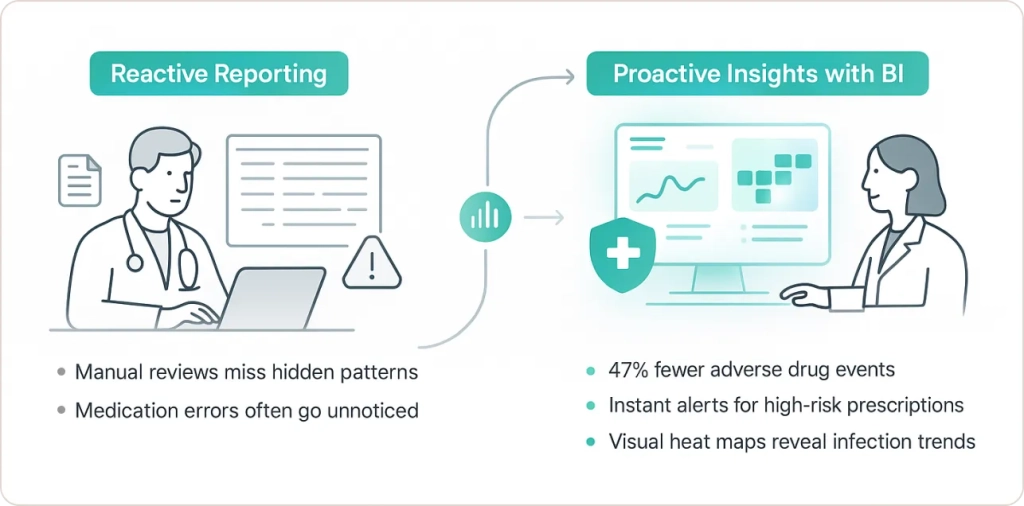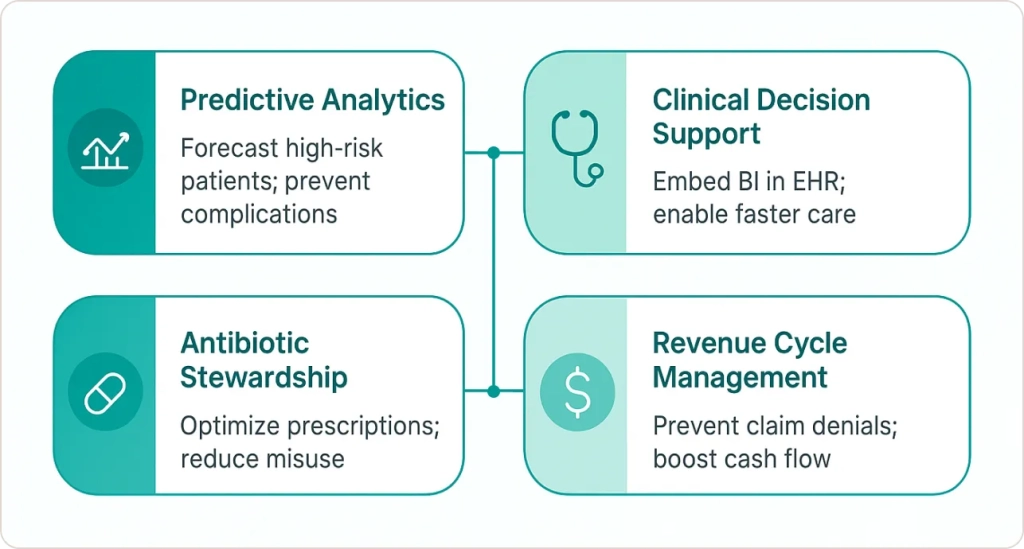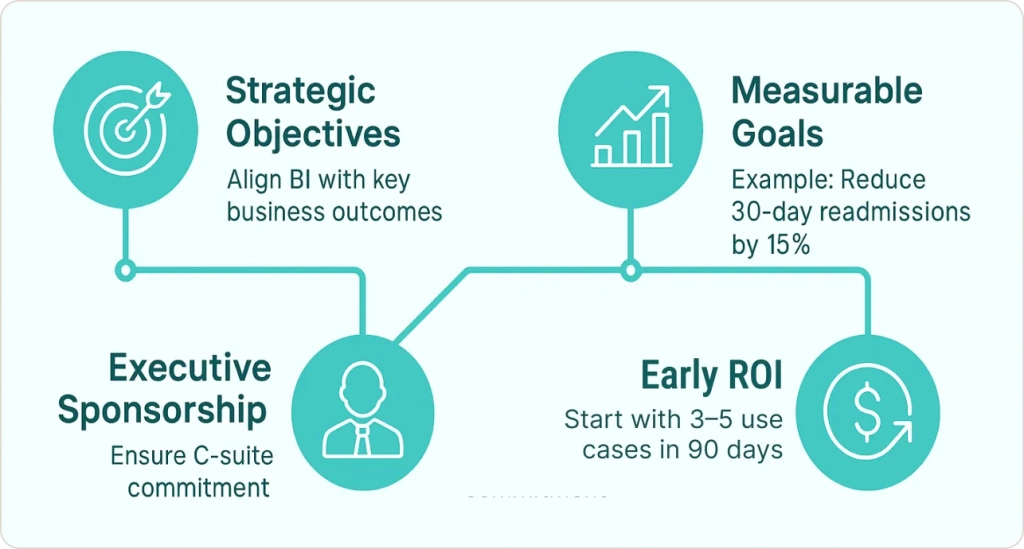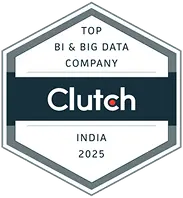Key Highlights
- Cleveland Clinic saved $150M annually using BI analytics platforms
- 97% of healthcare data remains unused without proper analytical tools
- Predictive models reduce hospital readmissions by 30% on average
- HIPAA-compliant BI enables real-time clinical decision support systems
- Value-based care mandates require sophisticated data governance frameworks
- Healthcare generates 30% of world’s data but lacks tools to extract value
Data-driven hospitals save lives and millions—here’s how BI makes it happen.
I’ve watched healthcare organizations struggle with a paradox over the past decade: they’re drowning in data yet starving for actionable insights. Electronic health records generate terabytes of patient information daily, but without business intelligence tools for healthcare to analyze it, that data becomes digital clutter rather than competitive advantage.
The healthcare industry produces roughly 30% of the world’s data volume, yet studies suggest 97% of it goes unused. That’s not just inefficiency—it’s missed opportunities to save lives, reduce readmissions, and cut operational waste.
The organizations winning in today’s value-based care environment aren’t collecting more data; they’re transforming it into strategic intelligence through purpose-built healthcare business intelligence solutions.
What changed? Three forces converged: regulatory pressure toward quality reporting, consumerization of healthcare creating demand for transparency, and post-COVID operational chaos. Business intelligence in healthcare evolved from nice-to-have analytics platforms into mission-critical infrastructure for survival.
Business intelligence in healthcare transforms clinical and operational data into actionable insights that improve patient outcomes while reducing costs. Healthcare organizations using BI tools achieve 300-500% ROI through predictive analytics, automated compliance, and proactive care management that prevents complications before they occur.
The Data Crisis Reshaping Healthcare Delivery
Hospitals now produce more data in a year than they can realistically use—up to 50 petabytes for a single 500-bed facility. That’s more information than the entire Library of Congress.
Electronic health records, medical imaging, genomic sequencing, wearable devices, and IoT-enabled equipment create continuous data streams that traditional reporting methods cannot process. This is precisely why business intelligence in healthcare industry has become essential rather than optional.
I’ve seen chief medical officers paralyzed by spreadsheet overload, trying to make million-dollar decisions with last month’s statistics. Real-time data visualization through BI in healthcare has become non-negotiable. When a patient’s vitals deteriorate, clinicians need instant risk stratification, not batch-processed reports delivered 24 hours later.
Value-Based Care Demands Better Analytics
Value-based care models fundamentally changed healthcare economics. Medicare’s Hospital Readmissions Reduction Program alone penalizes facilities up to 3% of total Medicare reimbursements for excess readmissions.
For large health systems, that’s tens of millions annually—losses that business intelligence in healthcare can prevent through predictive risk modeling.
Key regulatory drivers for BI solutions for healthcare:
- MACRA and MIPS require tracking dozens of clinical quality measures
- Manual chart reviews can’t meet compliance mandates at scale
- Business intelligence tools for healthcare automate quality metric extraction from EHRs
- Automated compliance frees clinical staff for direct patient care
COVID-19 Exposed Analytics Gaps
The pandemic served as a brutal stress test for healthcare data infrastructure. Organizations with mature business intelligence in healthcare capabilities pivoted rapidly:
- Redistributing ventilators based on predictive ICU demand models
- Forecasting PPE needs through supply chain analytics
- Monitoring staff exposure risk through contact tracing dashboards
Facilities relying on legacy reporting struggled with three-day-old census reports. Their competitors using real-time healthcare business intelligence solutions optimized bed capacity dynamically, reducing diversions and protecting market share.
How BI Improves Patient Outcomes and Safety

Predictive Analytics in Hospitals Save Lives
The most compelling use case for business intelligence in healthcare isn’t financial—it’s clinical. Kaiser Permanente reduced hospital readmissions by 30% using predictive analytics to identify high-risk patients before discharge.
Their business intelligence tools for healthcare analyze:
- Medication adherence patterns
- Social determinants of health
- Historical utilization trends
- Patient demographic risk factors
HCA Healthcare’s sepsis early warning system exemplifies life-saving BI in healthcare. Their algorithm analyzes vital signs, lab values, and clinical notes in real-time, alerting rapid response teams up to six hours before traditional screening criteria trigger.
This predictive model prevents approximately 2,000 deaths annually across HCA facilities.
BI Dashboards for Patient Outcomes
I’ve personally built medication error prevention dashboards using business intelligence in healthcare that cross-reference prescription orders against patient allergies, contraindications, and dangerous drug interactions instantaneously.
One health system using these healthcare business intelligence solutions reported 47% reduction in adverse drug events within the first year—directly attributable to pharmacists receiving automated alerts for high-risk orders.
According to the Agency for Healthcare Research and Quality, medication errors represent one of the most common types of preventable adverse events in healthcare settings. Data visualization transforms safety monitoring from reactive to proactive.
Instead of reviewing incident reports in text format, quality directors using BI solutions for healthcare see heat maps showing infection clusters by unit and time of day. Pattern recognition becomes intuitive, enabling root cause analysis that manual review methods miss entirely.
Operational Efficiency and Cost Reduction
Supply Chain and Staffing Optimization
The NHS United Kingdom deployed analytics dashboards that saved approximately £2.1M by optimizing bed management and reducing wait times. Their business intelligence in healthcare system predicts admission volumes by hour, allowing dynamic staffing adjustments and proactive transfer protocols before capacity crises occur.
Cleveland Clinic’s results with business intelligence tools for healthcare:
- $150M in annual cost savings from BI initiatives
- $23M recovered from unnecessary inventory carrying costs
- Supply chain optimization through usage pattern analysis
- Standardization opportunities identified through data
Emergency Department Throughput
I implemented BI solutions for healthcare tracking patient flow from triage through discharge across 18 touchpoints. By visualizing bottlenecks—often diagnostic imaging delays or specialty consultation waits—ED directors reduced length of stay by 38 minutes on average.
That efficiency gain through business intelligence in healthcare increased annual patient volume by 4,200 visits without adding physical capacity.
Revenue Cycle Management Success
Revenue cycle management benefits dramatically from healthcare business intelligence solutions:
| BI Application | Impact | Typical Results |
|---|---|---|
| Automated claim scrubbing | Identifies errors pre-submission | 22-35% denial reduction |
| Predictive bad debt models | Early financial counseling triggers | Improved collection rates |
| Coding optimization | Accurate reimbursement capture | Revenue enhancement |
Financial Performance Transparency
Healthcare business analytics enables total cost of care accounting impossible through traditional general ledger systems. Activity-based costing methodologies require integration of clinical documentation, supply chain transactions, labor records, and facility overhead—datasets siloed in separate systems without business intelligence in healthcare platforms bridging them.
I helped a multi-specialty group practice implement service line profitability analytics using business intelligence tools for healthcare, revealing their cardiology program—assumed to be a top performer—actually lost money after accurate indirect cost allocation.
The orthopedics service line subsidized cardiology operations, information completely obscured in aggregate financial statements. That intelligence from BI in healthcare redirected strategic investment and changed physician recruitment priorities.
Payer Contract Optimization
Payer contract optimization represents another powerful application of business intelligence in healthcare industry. By analyzing actual reimbursement rates against negotiated fee schedules across thousands of procedure codes, CFOs identify underpayment patterns and strengthen contract negotiations with quantitative evidence.
One hospital network recovered $4.7M in retroactive payments after their healthcare business intelligence solutions flagged systematic undercoding by a major insurer.
Critical Use Cases for Business Intelligence in Healthcare

Predictive Analytics for Population Health
Value-based care succeeds or fails on population health management capabilities. Accountable care organizations assume financial risk for patient cohorts, making predictive risk stratification through business intelligence in healthcare essential.
BI solutions for healthcare enable machine learning models that forecast which patients will become high utilizers, allowing proactive care management before expensive complications occur.
My experience building predictive models with business intelligence tools for healthcare:
- Combined clinical data, pharmacy claims, and social determinants of health
- Identified diabetic patients at risk of hyperglycemic crisis with 83% accuracy six months in advance
- Care coordinator interventions cost $1,200 per patient but prevented $45,000 average hospitalization costs
Chronic disease management programs demonstrate clear outcomes from business intelligence in healthcare. Remote patient monitoring devices transmit blood pressure, weight, and glucose readings to analytics platforms that automatically escalate abnormal trends to clinical teams.
One heart failure program using healthcare business intelligence solutions reduced 30-day readmissions from 19.4% to 11.7%, saving approximately $3.8M annually for a 300-bed hospital.
Clinical Decision Support Integration
The most sophisticated healthcare organizations embed business intelligence in healthcare directly into clinical workflows rather than treating analytics as separate reporting function. Real-time BI engines analyze patient data as clinicians document, offering evidence-based recommendations within the EHR interface.
Sepsis detection algorithms exemplify this integration of business intelligence tools for healthcare. Rather than requiring clinicians to navigate separate dashboards, alerts appear automatically in patient charts when predictive models indicate sepsis risk.
HCA Healthcare’s SPOT system analyzes 140 clinical variables every five minutes, achieving earlier identification than traditional screening criteria in 67% of sepsis cases.
Antibiotic Stewardship Programs
Antibiotic stewardship programs leverage BI in healthcare to promote appropriate prescribing. When physicians order broad-spectrum antibiotics, clinical decision support systems powered by business intelligence in healthcare display:
- Culture sensitivities and resistance patterns
- Local antibiogram data
- Guideline recommendations tailored to the specific infection
- Alternative therapy options
Hospitals using these healthcare business intelligence solutions reduced inappropriate antibiotic use by 31-43% while improving patient outcomes.
Revenue Cycle and Denial Management
Business intelligence in healthcare industry transforms revenue cycle management from reactive claim repair to proactive denial prevention. Predictive analytics identify claims likely to be denied before submission based on coding patterns, coverage rules, and historical adjudication data.
Case study: Denial prediction model using BI solutions for healthcare
- Built for large physician group
- 91% accuracy forecasting claim rejections
- Denial rates dropped from 8.2% to 3.1%
- Cash flow improved by approximately $11M annually
- Successful appeal rates increased from 43% to 68%
Prior authorization optimization represents another revenue cycle application of business intelligence tools for healthcare. These BI platforms analyze historical approval patterns to predict which services require authorization by payer, preventing claim denials due to missing authorizations.
One hospital network reduced authorization-related denials by $2.4M after implementing automated pre-service screening powered by healthcare business intelligence solutions.
Implementing Business Intelligence in Healthcare Successfully

Define Strategic Objectives First
Too many initiatives involving business intelligence in healthcare fail because organizations deploy technology without clear goals. I’ve watched expensive analytics platforms become expensive report generators because leadership never specified what decisions the business intelligence tools for healthcare should inform.
Successful initiatives often start with clear goals supported by reliable healthcare analytics solutions that align technology with measurable business outcomes.
Start with priority business problems:
- Frame objectives as measurable outcomes: “Reduce 30-day readmissions by 15%”
- Avoid vague goals like “Implement predictive analytics”
- Ensure BI in healthcare development focuses on high-value use cases
- Eliminate interesting-but-irrelevant analyses
Establish executive sponsorship with accountability. Business intelligence in healthcare requires sustained investment and organizational change management.
Without C-suite commitment, healthcare business intelligence solutions initiatives stall when competing priorities emerge or when analytics reveal uncomfortable truths about operational performance.
I recommend beginning with 3-5 concrete use cases demonstrating ROI from business intelligence in healthcare within 90 days. Early wins build organizational confidence and funding momentum for broader analytics expansion.
Ensure Data Quality and Governance
Business intelligence tools for healthcare only deliver value when underlying data is accurate, complete, and timely. Healthcare data quality challenges—duplicate patient records, incomplete documentation, inconsistent coding—undermine analytics reliability.
Critical governance steps for BI solutions for healthcare:
- Define data stewards responsible for quality within each source system
- Establish validation rules and standardize terminology
- Create master data management protocols for patient, provider, and facility identifiers
- Implement data quality monitoring dashboards
I’ve seen analytics teams waste months troubleshooting dashboard discrepancies caused by upstream data quality issues. One health system’s readmission reports showed 43% 30-day readmission rate—impossibly high—because their ADT system created duplicate encounters for patients transferring between units.
Interoperability remains a healthcare-specific data challenge. Clinical information often exists in multiple EHR platforms, practice management systems, and specialty applications. Healthcare business intelligence solutions require integration layers—FHIR APIs, HL7 interfaces, or data warehouses—aggregating information from these disparate sources.
Top BI Tools for Healthcare Organizations
BI solutions for healthcare range from general-purpose platforms like Power BI and Tableau to healthcare-specific vendors offering pre-built clinical and financial analytics. Tool selection for business intelligence in healthcare depends on organizational technical capabilities, budget, and use case requirements.
| Platform | Best For | Key Strengths |
|---|---|---|
| Power BI | Most hospitals | Cost-effectiveness, Microsoft integration, HIPAA compliance |
| Tableau | Large health systems | Superior visualization, handles massive datasets |
| Health Catalyst | Organizations lacking analytics talent | Pre-configured healthcare analytics, domain expertise |
| Arcadia | Population health focus | Rapid deployment, sophisticated capabilities |
Power BI excels for organizations seeking flexibility and Microsoft ecosystem integration as business intelligence tools for healthcare. Its healthcare dashboard templates accelerate time-to-value, while custom development capabilities support unique organizational needs.
I’ve implemented Power BI as a business intelligence in healthcare solution for 20+ healthcare clients, appreciating its cost-effectiveness and Azure cloud security features supporting HIPAA compliance.
Tableau offers superior data visualization capabilities and handles massive datasets efficiently—important for large health systems implementing business intelligence in healthcare industry. Its Healthcare Blueprint provides industry-specific KPIs and metrics frameworks, though customization requires specialized expertise.
ROI of BI in Healthcare: Measuring Real Returns
Healthcare organizations need systematic approaches quantifying business intelligence in healthcare value beyond anecdotal success stories. I use a five-component ROI framework assessing: cost avoidance, revenue enhancement, productivity improvement, quality outcome gains, and risk mitigation.
Quantitative ROI Framework for Business Intelligence Tools for Healthcare
| ROI Component | Measurement Method |
|---|---|
| Cost Avoidance | Expenses prevented through BI interventions (e.g., readmissions, complications) |
| Revenue Enhancement | Denied claims recovered, coding optimization, market share gains |
| Productivity Improvement | Staff time savings redirected to higher-value work |
| Quality Outcome Gains | Prevented adverse events, reduced mortality, improved satisfaction |
| Risk Mitigation | Compliance penalties avoided, regulatory reporting automation |
Revenue enhancement measures incremental income attributed to healthcare business intelligence solutions capabilities—denied claims recovered, coding optimization improving reimbursement accuracy, or market share gains from quality reputation.
One physician group’s denial management analytics using business intelligence in healthcare generated $847,000 additional annual revenue by prioritizing high-value appeals and preventing submission errors.
Quality outcome value remains challenging to monetize but represents the most important benefit of business intelligence in healthcare. Preventable medical errors cost the US healthcare system approximately $20 billion annually. Assign dollar values to prevented adverse events, reduced mortality, and improved patient satisfaction scores using these benchmarks.
Future Trends: AI and Advanced Analytics in BI
The convergence of business intelligence tools for healthcare with AI capabilities marks the next analytics evolution. According to McKinsey & Company research, AI applications integrated with business intelligence in healthcare could create $150 billion in annual savings for the US healthcare economy by 2026.
Natural language processing enables automated clinical documentation analysis. This technology extracts insights from unstructured notes, radiology reports, and pathology findings that traditional BI in healthcare cannot access.
AI-Powered Clinical Documentation
NLP transforms how business intelligence in healthcare processes unstructured data:
- Identifies social determinants of health buried in clinical narratives
- Surfaces housing instability, food insecurity, and transportation barriers
- Extracts risk factors that structured data fields miss entirely
- Automates coding and documentation quality reviews
Computer vision applications analyze medical imaging at scale. These AI capabilities detect abnormalities radiologists might overlook and quantify disease progression with unprecedented precision.
Generative AI Transforms User Interaction
Generative AI will revolutionize how clinicians interact with business intelligence tools for healthcare. Instead of building complex dashboards, users will ask conversational questions.
Examples of conversational BI queries:
- “Which patients in my panel are overdue for diabetic eye exams?”
- “Show me high-risk heart failure patients likely to be readmitted”
- “What’s causing the spike in ED wait times this week?”
The healthcare business intelligence solutions will understand intent, query relevant data, and respond with actionable patient lists—democratizing analytics access beyond technical users.
Interoperability Enables Comprehensive Data Exchange
Federal mandates and HL7 FHIR adoption are dismantling information silos. The 21st Century Cures Act requires healthcare providers to implement standards-based APIs, enabling real-time data exchange across organizations.
Key interoperability drivers for BI solutions for healthcare:
- Real-time patient data sharing across health systems
- Comprehensive views incorporating external encounters
- Community service utilization tracking
- Social services referral integration
Wearable devices and remote patient monitoring create continuous data streams. The global remote patient monitoring market is projected to reach $175.2 billion by 2030, growing at 26.7% annually.
Benefits of integrating consumer-generated health data:
- Daily living pattern visibility beyond clinical encounters
- Medication adherence monitoring in real-time
- Early warning signs of patient decompensation
- Activity level tracking for chronic disease management
One heart failure program combining Fitbit activity data with business intelligence in healthcare reduced hospitalizations by 41% compared to traditional monitoring approaches.
The Path Forward with Business Intelligence in Healthcare
Healthcare organizations cannot afford intuition-based decisions in today’s value-based environment. Business intelligence in healthcare has evolved from optional analytics into essential infrastructure for clinical quality, operational efficiency, and financial sustainability.
Start small, but start now. Begin with one high-impact use case for business intelligence tools for healthcare, demonstrate ROI, build organizational confidence, and scale systematically. The question isn’t whether to implement healthcare business intelligence solutions, but how quickly you can transform data into strategic advantage.
Looking to unlock your healthcare data’s full potential? Professional Business Intelligence Services can accelerate your analytics journey with proven frameworks and industry-specific best practices.














